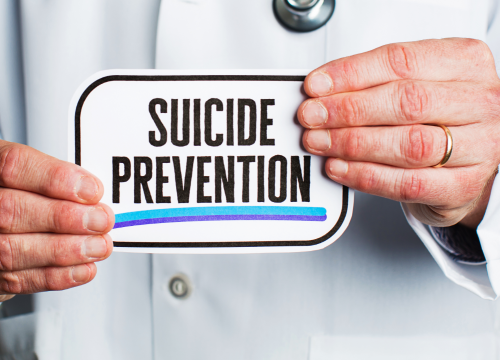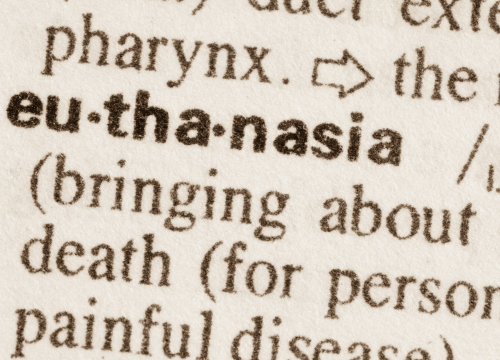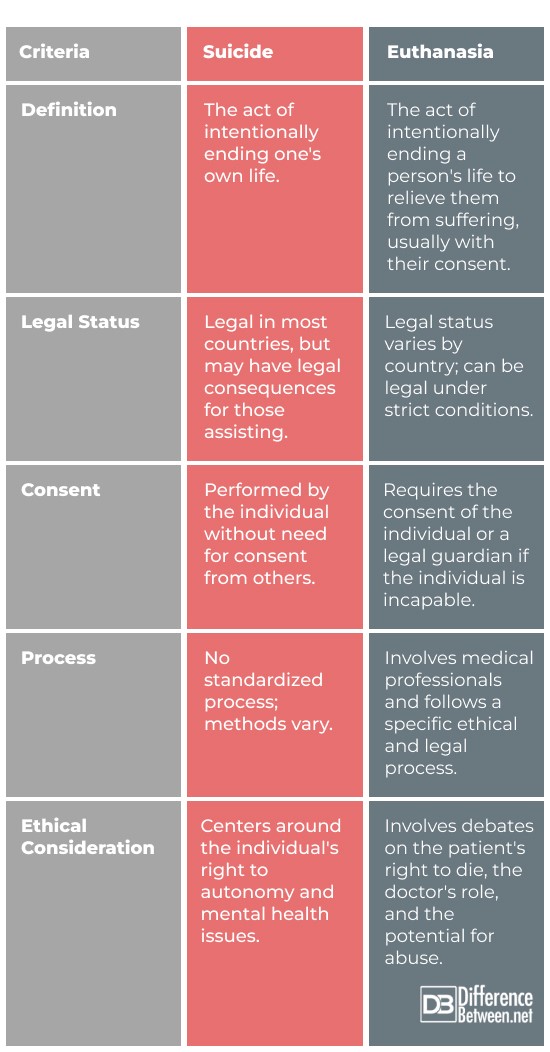Difference Between Suicide and Euthanasia
In this article we will talk about the differences between two very important human experiences: suicide and euthanasia. People often get these two terms mixed up or confused, even though they both raise important ethical, legal, and social issues. Putting an end to one’s own life, or suicide, is a sign of deep depression and is frowned upon by society. Euthanasia, also known as “assisted dying,” is the act of ending a person’s life to relieve their suffer, usually with their consent. It has become a controversial issue in both law and moral arguments.
It’s not enough to just understand these differences for academia; we need to know about them in order to create caring society, smart laws, and responsible medical practices. The goal of this article is to break down the meanings, situations, and effects of suicide and euthanasia so that these important topics are clearer. We want this study to help people understand and talk about the ideas of autonomy, respect, and the value of life in a more nuanced way.

What is Suicide?
Definition
Suicide is the act of killing yourself on purpose. People make this choice for a lot of different, complicated reasons. It’s often seen as their last chance to escape pain that seems unbearable.
Causes and Risk Factors
A higher chance of suicide can be caused by a number of things, such as, but not limited to:
- Mental health problems like depression, bipolar disorder, schizophrenia, anxiety, and drug abuse all play a big role in this.
- Having suicidal ideas can be caused by traumatic events like abuse, the death of a loved one, or difficult life events.
- Isolation and a lack of social support: Feeling alone can make suicide thoughts worse or even start them.
- Chronic illnesses: Being depressed and having suicide thoughts can be caused by sicknesses or physical problems.
- Family history: If someone in your family has committed suicide or had a mental illness, the risk may be higher.
Psychological and Social Implications
Not only does suicide affect the person who did it, but it also affects their family, friends, and the community as a whole. People who have survived may feel many things, such as sadness, guilt, anger, and confusion. People who have lost someone to suicide may also feel shame, which can make it hard for them to get help. The psychological effects can cause mental health problems in the community, which can start a loop that could affect other people who are already at risk.
Legal and Ethical Considerations
Different places have very different laws about what happens when someone commits suicide. In some places, suicide or attempted suicide is a crime. In others, it’s not a crime but the person may have to go to mental health care against their will. In terms of ethics, suicide makes us think about our own freedom, the worth of human life, and the part that society and mental health services should play in stopping these kinds of tragedies. The goal of the law and moral systems is to balance the rights of each person with the larger goal of keeping people safe.
Understanding suicide from these points of view helps make efforts to stop it, help people who are going through it, and lower the shame that surrounds it. This leads to more caring and effective ways to mental health and the well-being of society as a whole.

What is Euthanasia?
Definition
Euthanasia, which is also sometimes called “mercy killing,” is the act of ending someone’s life on purpose so they don’t have to suffer. It usually applies to people with fatal or severely crippling illnesses who want to end their pain and suffering in a kind and moral way.
Types of Euthanasia
There are different types of euthanasia, each with its own unique traits:
- Active euthanasia means directly killing someone by doing things like giving them a deadly amount of medicine.
- Passive euthanasia means letting someone die by stopping treatments that keep them alive, like food tubes or ventilators.
- Voluntary euthanasia is when the person who is dying gives their clear permission for it to happen.
- Non-voluntary euthanasia is done when the person can’t give permission or say what they want, usually because they are unconscious or don’t have mental capacity.
Ending someone’s life against their will or without them knowing is called involuntary euthanasia. In most places, this is illegal and considered murder.
Legal and Ethical Considerations
Different places in the world have very different laws about suicide. In some countries, euthanasia is legal in certain ways, like when it is choice or silent. In others, it is illegal in any way. People who disagree with euthanasia mostly talk about liberty, the right to die, the sanctity of life, and the slippery slope argument, which says that allowing euthanasia could lead to other kinds of killing that aren’t as moral.
Religious and personal views about life and death, what it means to suffer, and the duties of medical workers are often at the heart of moral decisions. These things add to the current, very heated arguments about the subject.
How it’s done and Who It Affects
In order to make sure that the choice to euthanasia is legal and in line with the patient’s wishes, it is generally followed by strict legal rules, medical evaluations, and ethical consultations. It changes not only the person who chooses suicide, but also their family, their healthcare workers, and the way people think about life and death in general. The effect is huge, making everyone involved feel complicated feelings and moral problems.
Understanding suicide from these points of view can help people, families, and lawmakers make choices about end-of-life care that are moral, legal, and emotional.
Possible Similarities Between Suicide and Euthanasia
Although suicide and euthanasia are different, they share moral reasons, impacts on families and society, and psychological underpinnings.
Moral Arguments
Considerations for suicide and euthanasia involve significant moral discussions concerning life, liberty, and a “good” death. Both concerns revolve around “Is it ever right to end your own life or the life of another?” and “Who has the right to make such decisions?” When discussing morality, rights, and society, these debates can become difficult.
Personal and Family Impact
Both activities can affect family and group members’ minds and emotions. After a loved one commits suicide or euthanasia, people may feel sad, guilty, and that they need to blame someone. These occurrences may also challenge people’s views on death and dying, which could affect culture or legislation. Shame and isolation can make it harder for families to obtain treatment and heal.
Psychological foundations
Both suicide and euthanasia have psychological causes, although differently. Euthanasia may be chosen to escape excruciating suffering or losing respect due to terminal disease. People who consider suicide may be driven by mental anguish, grief, or hopelessness. Self-determination, whether by suicide or euthanasia, stems from basic psychological needs for independence, pain relief, and not being a burden.
Realizing these linkages helps us discuss suicide and euthanasia with greater compassion and knowledge.
Differences Between Suicide and Euthanasia
While suicide and euthanasia have certain parallels, they differ in key ways:
intent and consent
A person actively commits suicide without consent or legal or ethical permission.
Euthanasia: When a doctor ends a patient’s life with the patient’s consent or a legal guardian’s agreement.
legal implications and status
Suicide: Legal in most places, however local laws may punish surviving family members or accomplices.
Euthanasia: Laws vary widely by country and state. Other places consider euthanasia illegal and homicide, while others authorize it under strict conditions.
Morality and Ethics
Suicide: Moral debates often pit autonomy against life. Religion and culture strongly impact these opinions.
Euthanasia: Raises difficult ethical considerations about medical professionals’ role in ending life, patient autonomy versus societal norms, and abuse or slippery slope scenarios.
Cultural and Social Views
Suicide: Stigmatized and linked to mental illness, causing social isolation and lack of support.
Euthanasia: Can be perceived as compassionate or immoral depending on culture and religion.
Medical Procedures
Suicide: Methods and goals vary; no medical supervision or ethical norms.
Euthanasia: Medical professionals follow particular processes and rules to secure the patient’s consent and knowledge to deliver a painless and dignified death.
Additional Differences
Mental State: Suicide victims may have untreated mental health issues, while euthanasia patients may be in excruciating pain.
Support Systems: Suicide sufferers frequently decide alone, while euthanasia sufferers consult with doctors, family, and lawyers.
These variances show how complicated each act is and how important it is to understand from legal, ethical, psychological, and societal perspectives.
Differences Between Suicide and Euthanasia

Summary
In our examination of suicide and euthanasia, it’s crucial to recognize their distinct characteristics and the significant societal implications. Suicide, an individual act often resulting from personal distress, lacks a collective ethical framework and is marked by societal stigma. Euthanasia, conversely, involves medical intervention under the patient’s consent and is subject to varied legal and ethical considerations across different regions.
Your understanding should transcend academic knowledge, influencing ethical practices and societal attitudes towards end-of-life issues. It’s essential to approach these topics with empathy, critical thought, and an awareness of the broader societal impacts. Your role extends beyond academia into shaping informed, compassionate, and ethical responses to these complex human experiences.
FAQs
Euthanasia and Assisted Suicide
What’s disability got to do with it?
Disability concerns in euthanasia and assisted suicide involve ethical debates on autonomy, quality of life, and societal values regarding disabled lives.
Isn’t assisted suicide for people who are terminally ill?
Primarily, yes. Assisted suicide is usually reserved for terminally ill individuals, though laws vary by location.
Aren’t there safeguards in place for Euthanasia?
Yes, there are strict legal and medical safeguards designed to protect patients and ensure that the decision is voluntary and informed.
Who is eligible for assisted death in Canada?
Adults suffering from grievous and irremediable medical conditions, who make a voluntary request and give informed consent, are eligible.
What does euthanasia do to the body?
Euthanasia typically involves administering substances that painlessly end life, stopping heart and respiratory functions.
What is the process of euthanasia?
The process involves legal and medical evaluations, consent verification, and the administration of life-ending substances under medical supervision.
What percent of terminally ill patients want euthanasia?
This varies widely based on individual beliefs and circumstances; not all terminally ill patients choose euthanasia.
How much does euthanasia cost in Canada?
Costs vary; some services are covered by healthcare systems, but there may be associated costs depending on the situation and location.
How long does assisted death take in Canada?
The process can vary but usually involves several weeks to months from request to procedure, depending on individual cases and legal requirements.
Is euthanasia pain free?
Euthanasia is designed to be painless, though individual experiences may vary based on the method used.
How long does it take to be approved for MAID (Medical Assistance in Dying)?
Approval times can vary but generally involve a minimum waiting period and assessments, typically spanning weeks to months.
How long does it take for MAID to take effect?
Once administered, the substances used in MAID typically take effect within minutes.
What pills are given for MAID?
The specific medications can vary but usually include a combination designed to induce a painless and peaceful death. Some of the medications used are propofol, midazolam and rocuronium.
What happens to the body after MAID?
Following MAID, the body undergoes natural processes similar to any death, ceasing biological functions.
How do I get approved for MAID?
Approval involves a formal request, assessments by healthcare professionals, and meeting the eligibility criteria under Canadian law.
Suicide
What conditions cause high suicide rates?
Conditions like depression, bipolar disorder, schizophrenia, and substance abuse are linked to higher suicide rates.
What are the 4 types of suicide?
Durkheim identified egoistic, altruistic, anomic, and fatalistic suicides.
What are the effects of patient suicide?
Effects can include profound grief, trauma, and guilt among family, friends, and healthcare providers.
What is a common symptom of depression and suicide?
A common symptom is a profound sense of hopelessness.
What is the number one suicide disease?
Depression is often referred to as the top condition linked to suicide.
What are the major physical health conditions and risk of suicide?
Conditions include chronic pain, serious illnesses like cancer, and debilitating physical conditions.
Which occupation is considered to have the highest risk for suicide?
High-risk occupations include healthcare, law enforcement, and military personnel.
What country has the highest suicide rate?
As of recent data, countries like Lithuania and South Korea have high suicide rates.
Which are risk factors for suicide? (Select four)
Mental illness, substance abuse, history of trauma or abuse, and family history of suicide.
- Difference Between Suicide and Euthanasia - May 22, 2024
- Difference Between Vitamin D and Vitamin D3 - May 21, 2024
- Difference Between Running Shoes and Walking Shoes - April 30, 2024
Search DifferenceBetween.net :
3 Comments
Leave a Response
References :
[0]Masango, S. M., Rataemane, S. T., & Motojesi, A. A. (2008). Suicide and suicide risk factors: A literature review. South African Family Practice, 50(6), 25-29.
[1]Mościcki, E. K. (1997). Identification of suicide risk factors using epidemiologic studies. Psychiatric Clinics of North America, 20(3), 499-517.
[2]Meyer, R. E. (2015). Euthanasia and humane killing. Veterinary anesthesia and analgesia: the fifth edition of Lumb and Jones, 130-143.
[3]Lewis, P. (2007). The empirical slippery slope from voluntary to non-voluntary euthanasia. Journal of Law, Medicine & Ethics, 35(1), 197-210.
[4]Emanuel, E. J., Onwuteaka-Philipsen, B. D., Urwin, J. W., & Cohen, J. (2016). Attitudes and practices of euthanasia and physician-assisted suicide in the United States, Canada, and Europe. Jama, 316(1), 79-90.
[5]Masango, S. M., Rataemane, S. T., & Motojesi, A. A. (2008). Suicide and suicide risk factors: A literature review. South African Family Practice, 50(6), 25-29.
[6]Mościcki, E. K. (1997). Identification of suicide risk factors using epidemiologic studies. Psychiatric Clinics of North America, 20(3), 499-517.
[7]Meyer, R. E. (2015). Euthanasia and humane killing. Veterinary anesthesia and analgesia: the fifth edition of Lumb and Jones, 130-143.
[8]Lewis, P. (2007). The empirical slippery slope from voluntary to non-voluntary euthanasia. Journal of Law, Medicine & Ethics, 35(1), 197-210.
[9]Emanuel, E. J., Onwuteaka-Philipsen, B. D., Urwin, J. W., & Cohen, J. (2016). Attitudes and practices of euthanasia and physician-assisted suicide in the United States, Canada, and Europe. Jama, 316(1), 79-90.
[10]Image credit: https://www.canva.com/photos/MAEEdmd31AA/
[11]Image credit: https://www.canva.com/photos/MAC43cf5bgE-dictionary-definition-of-word-euthanasia/

This article has a bias toward euthanasia, by saying it is used in “order to stop pain and suffering” but saying suicide is committed out of despair or because of mental illness. You never mention that the mentally ill commit suicide to end their pain and suffering. The motivation is the same.
Suicide is done to end pain and suffering. Many ppl who commit suicide have suffered years of uncontrolled chronic pain after accidents,over dose on medication drug abuse or other methods.
There are none. Do not lie.